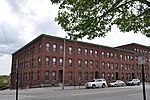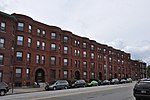St. George's School and Convent
National Register of Historic Places in Manchester, New HampshireProperties of religious function on the National Register of Historic Places in New HampshireRoman Catholic churches in Manchester, New HampshireRomanesque Revival architecture in New HampshireSchool buildings completed in 1898 ... and 1 more
School buildings on the National Register of Historic Places in New Hampshire

St George's School and Convent are a historic Roman Catholic complex at 124 Orange Street in Manchester, New Hampshire, United States. Built in 1898–99, they are among the city's finest examples of Romanesque architecture, built to support its burgeoning French Canadian population. The school closed in 1970, after which time the buildings have been used to house social service agencies and act as a community center. The buildings were listed on the National Register of Historic Places in 1985.
Excerpt from the Wikipedia article St. George's School and Convent (License: CC BY-SA 3.0, Authors, Images).St. George's School and Convent
Myrtle Street South Back, Manchester
Geographical coordinates (GPS) Address Nearby Places Show on map
Geographical coordinates (GPS)
| Latitude | Longitude |
|---|---|
| N 42.996944444444 ° | E -71.46 ° |
Address
New Testament Fellowship
Myrtle Street South Back
03108 Manchester
New Hampshire, United States
Open on Google Maps







